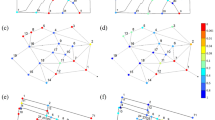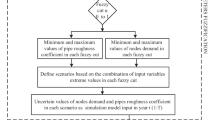Abstract
Water shortage is experienced in different parts of the world in different magnitude. In certain countries, water deficit is a regular phenomenon and in some other countries it happens for a short duration, due to failure of any component in the system. Shortage of water at source can be best tackled by distributing the available water equally among the consumers. This paper deals with the design of water distribution network capable of equitable supply during shortage in addition to the satisfactory performance under non-deficit condition. Performance of a typical water distribution network, with shortage of water at source is illustrated in detail. Head dependent outflow analysis with extended period simulation, is used to determine the actual supply from each node to consumers. Relationship between duration of supply and volume available at source as well as supply from each node are established for understanding the behaviour of network under low supply situation. A term “inequity” which is the maximum difference in supply demand ratio among different consumers is presented. This is based on the actual performance of the network instead of surrogate measures, generally used for reliability. It is illustrated that the maximum “inequity” in supply in a network during the entire duration of supply can be estimated with single analysis. Design of a water distribution network, duly considering equity in addition to the cost minimization and minimum head requirement is presented. Genetic Algorithm is used for solving this multi objective problem. The solution technique is illustrated using two benchmark problems, namely two loop network and Hanoi network. Results show that considerable improvement in equitable supply can be achieved with additional investment on pipes above the least cost solution. Hence it is better to design networks duly considering deficit condition for better reliability. It is also illustrated that it will be difficult to improve equity beyond a limit for a given network, through selection of different pipe diameters.






Similar content being viewed by others
References
Agarwal ML, Rajesh Gupta, Pramod R Bhave (2007) Reliability based strengthening and expansion of water distribution networks. J Water Resour Plan Manag 531–541
Ashley MJ, Kocha ME, Routh JD (2000) Some experiences with depressurized and low flow systems in the UK. Proc. Intl Seminar on Intermittent Drinking Water Supply Syst Manag, IWWA. Mumbai, 17–18
Chandapillai J (1991) Realistic simulation of Water Distribution System. ASCE J Transp Eng 117(2)
Chandapillai J, Narayana Iyer R (2001) Equitable distribution of water though pipe network under low supply situation. Proc. of the 4th International Conference on Water Pipeline Systems, BHR Group 28–30 March, York, UK
Creaco E, Franchini M, Alvisi S (2010) Optimal placement of isolation valves in water distribution systems based on valve cost and average demand shortfall. Water Resour Manag 24(15):4317–4338
Deb K et al (2000) A fast and elitist multi-objective genetic algorithm: NSGA II. Technical report 200001, Indian Institute of Technology, Kanpur Genetic Algorithm Laboratory, KanGAL, Kanpur, India
Farmani Raziyeh, Walters Godfrey A, Savic DA (2005) Trade off between total cost and reliability for any town water distribution network. J of Water Resour Plann Manag 161–171
Fujiwara Okitsugu, Jun Li (1998) Reliability analysis of water distribution networks in consideration of equity, redistribution and pressure dependent demand. Water Resour Res 34(7):1843–1850
Gupta R, Bhave PR (1994) Reliability analysis of water distribution systems. J Envi Eng 447–460
Gupta R, Pramod R Bhave (1996) Comparison of Methods for predicting deficient network performance. J Water Resour Plann Manag 214–217
Jayaram N, Srinivasan K (2008) Performance-based optimal design and rehabilitation of water distribution networks using life cycle costing. Water Resour Res 44(W01417):1–15
Kadu SM, Rajesh G, Pramod RB (2008) Optimal design of water networks using a modified genetic algorithm with reduction in search space. J Water Resour Plann Manag 147–160
Liberatore S, Sechi GM (2009) Location and calibration of valves in water distribution networks using a scatter-search meta-heuristic approach. Water Resour Manag 23(8):1479–1495
Mays LW (2000) Water Distribution Systems Handbook. McGrawHill, New York
Prasad DT, Nam Sik Park (2004) Multiobjective Genetic Algorithms for design of water distribution networks. J Water Resour Plann Manag 73–82
Reca J, Martinez J, Banos R, Gil C (2008) Optimal design of gravity fed looped water distribution networks considering the resilience index. J Water Resour Planning Manag 234–238
Rossman LA (2000) EPANET Users Manual, U.S Environmental Protection Agency, Cicinnati, Ohio
Soltanjali M, Bozorg-Haddad O, Marino MA (2011) Effect of breakage level one in design of water distribution networks. Water Resour Manag 25(1):311–337
Reddy LSrinivasa, Elango K (1989) Analysis of Water distribution networks with head dependent outlets. Civil Eng Syst 6(3):102–110
Tanyimboh TT, Tabesh M, Burrows R (2001) Appraisal of source head methods for calculating reliability of water distribution networks. J Water Resour Plann Manag 206–213
Todini Ezio (2000) Looped water distribution networks design using resilience index based heuristic approach. Urban Water 2(3):115–122
Udo Akihiko, Takao Ozaw (2001) Steady state Analysis of Pipe Networks considering Reduction of Outflow in case of low water pressures. In: Proceedings of the International Conference on computing and control for the water Industry CCWI 2001. De Montfort University, Leicester, United Kingdom
Vairavamoorthy K (2000) An appropriate design tool for intermittent water supply systems. Proc. Of the international seminar on Intermittent drinking Water Supply System Management, IWWA. Mumbai, 17–18
Wu Zheng Y, Wang Rong H, Walski Thomas M, Yang Shao Y, Danniel Bowdler, Bhaggatt Christopher C (2009) Extended Global Gradient Algorithm for pressure-dependent water distribution analysis. J Water Resour Plann Manag ASCE 135(1):13–22
Acknowledgement
The authors wish to express sincere gratitude to their colleagues and family members who helped in the work.
Author information
Authors and Affiliations
Corresponding author
Rights and permissions
About this article
Cite this article
Chandapillai, J., Sudheer, K.P. & Saseendran, S. Design of Water Distribution Network for Equitable Supply. Water Resour Manage 26, 391–406 (2012). https://doi.org/10.1007/s11269-011-9923-x
Received:
Accepted:
Published:
Issue Date:
DOI: https://doi.org/10.1007/s11269-011-9923-x




